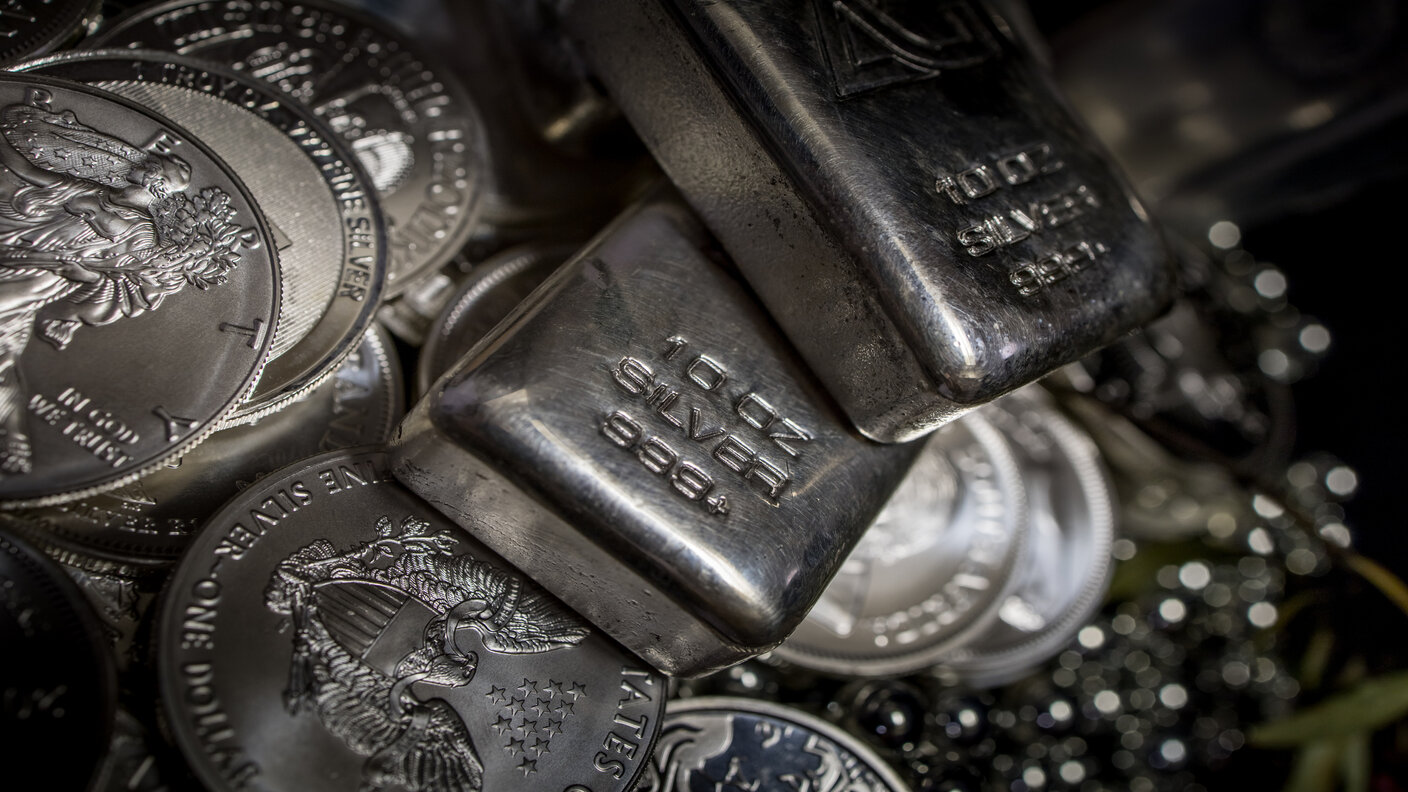Silver set to surge after years in the doldrums
Fans of the devil’s metal have faced frustration. But that may be about to change.

Silver is often described as the “devil’s metal”. It is extremely volatile and has a startling ability to burn holes in investors’ pockets. Never has the latter trait been more evident than in recent months. In March 2011, silver hit $48.60 per ounce, a record peak. Three years ago, it traded at $28.50/oz. Yet now, in real (inflation-adjusted) terms, dollar-priced silver is hardly any higher than it was just after World War I.
The metal’s underperformance is thrown into sharp relief by the gold/silver ratio. This indicates how many silver ounces equal one gold ounce (there’s more on this topic later on). At present, the ratio shows that silver is looking cheap compared with bullion. However, with silver’s fundamentals both strong and improving, it could soon be re-rated relative to gold.
Why? For starters, silver is an industrial metal whose range of applications keeps growing. It is extremely durable, one of the world’s best electricity conductors, and is particularly suited to coating electrical contacts on printed circuit boards. So it is used in nearly all computers and mobile phones, as well as in electricity-producing solar cells and plasma-display panels. Televisions’ on/off buttons, microwave ovens, toys and keyboards employ silver membrane switches. Silver ink removes the need for wires. Silver in medical devices, bandages and ointments fights infections. Furthermore, water-purification systems use silver ions as a sanitiser, in particular, to counter antibiotic-resistant bacteria such as MRSA. Silver is also used within the vehicle, power generation and construction sectors. It is very popular in the jewellery industry too; it is often alloyed to improve durability – in sterling silver, for instance, which constitutes 92.5% silver and 7.5% other metals.
MoneyWeek
Subscribe to MoneyWeek today and get your first six magazine issues absolutely FREE

Sign up to Money Morning
Don't miss the latest investment and personal finances news, market analysis, plus money-saving tips with our free twice-daily newsletter
Don't miss the latest investment and personal finances news, market analysis, plus money-saving tips with our free twice-daily newsletter
Last year, overall silver supply was estimated at just over one billion ounces, according to the Silver Institute (SI), 820 million ounces of which came from mine production (the second-lowest level for a decade). Overall demand for silver in 2023 was 1.14 billion ounces, according to the SI, 632 million ounces of which stemmed from industry and 208 million from photography and jewellery. Net investment in physical silver (coins and bars), although in line with historic levels, actually declined by 20% from 2022, which helps to explain the recent weakness in the metal’s price. However, this still left a silver deficit for last year of around 140 million ounces. In the near term, there are risks attached to silver’s market value. If the US were to go into recession (still quite possible), industrial demand for silver would be adversely affected. Meanwhile, business confidence in China may remain fragile, so Chinese silver usage could be sluggish for the next few months.
Supply squeeze
Looking beyond 2024, however, the outlook for silver is highly auspicious. In particular, one major supply-side hurdle is approaching.
Mexico is the planet’s top silver producer, supplying almost a quarter of global output, according to the United States Geological Survey (USGS). However, Mexico’s silver production is now declining at a double-digit annual rate, notes Tavi Costa at money manager Crescat Capital. Why? Labour, political and environmental activism is mounting. Last year, the Mexican government overhauled mining laws, including shorter concessions and tighter rules for permits. Mexico’s silver reserves are therefore dwindling. By 2026, at current production rates, they could be exhausted.
By contrast, the artificial intelligence (AI) boom could mean surging demand for precious metals in 2024, notes researcher SchiffGold. Precious-metals research consultancy Metals Focus recently forecast that increased demand for chips powering AI would drive “widespread support for a range of precious metals-bearing components”.
In addition, by 2027 solar manufacturers will need more than 20% of annual silver supply, says the University of New South Wales. It expects that by 2050 solar panel production will comprise 85%-98% of current global silver reserves. Oxford Economics forecasts that “between 2023 and 2033... the output of end users of industrial silver will increase by 46% in real terms”.
Could the flood of liquidity return?
Another major factor for silver is overall demand from investors, which is set to continue rising in the long term as investors worldwide seek a hedge against inflation and a store of value.
And it could well receive a near-term fillip too. America’s rising inflation rate in 2021 and 2022 drove the US Federal Reserve to keep hiking interest rates. It has also operated quantitative tightening (QT, or reducing the amount of printed money in the system) rather than quantitative easing (QE, adding printed money to the system). This looks set to change, though. It appears that America’s financial plumbing is starting to clog up as liquidity is removed from the system; there are signs that the current cash surplus in money markets is rapidly diminishing.
Lorie Logan, president of the Reserve Bank of Dallas, “has confirmed that the Fed’s QT is effectively over due to the sudden unexpected slide in systemic liquidity”, says news site ZeroHedge. In plain English, this means that cash in the US system is soon set to dry up.
“The Fed is on course to end QT and restart QE in the coming months, against a backdrop of loose fiscal policy and a still-resilient economy, opening the door to a reappearance of inflationary pressures that the Fed may have little appetite (or ability) to restrain,” agrees Melissa Davies, chief economist at hedge fund Redburn Atlantic, in the Financial Times.
With the money supply likely to take off again, the value of bullion, the classic safe haven during times of political and/or inflationary stress, is set to surge once more. However, silver acts as an even more potent monetary barometer, having historically mimicked – and indeed amplified – movements in gold. To return to the gold/silver ratio.
It’s “the oldest continuously tracked exchange rate in history”, says Investopedia, as gold and silver prices “have such a well-established correlation. For the whole of the 20th century, the average gold/silver ratio was 47:1. In the 21st century, the ratio has ranged mainly between 50:1 and 70:1, with a low of 35:1 in 2011.
Lower real yields will boost precious metals
The current gold/silver ratio is around 88, near the top of its 100-year range between 15 and 113. A return to just the mid-point of that century-long spread (around 64, even assuming unchanged gold) would lift silver to almost $32. If the ratio were to compress to the 20th century’s average level of 47, again presuming that gold stays still, silver would rise to $43 per ounce.
“The Fed cutting cycle and falling US real yields are expected to push gold prices to new nominal highs in the middle of 2024, reaching an average of $2,175/oz by the fourth quarter,” says J.P. Morgan. “Silver prices will probably follow gold, averaging around $30/oz in the fourth quarter.”
Commerzbank also expects silver to climb to $30 by the end of 2024, which would bring the gold/silver ratio down to 72. By themselves, those would be very good returns. But silver could do even better. That is because, in precious metal bull markets, it normally outperforms gold, having lagged it in the early stages. Indeed, most of silver’s appreciation tends to be seen in the bull market’s latter stages.
“We expect silver to clear $26/oz, which will open the door to $34/oz,” says Taki Tsaklanos at InvestingHaven. “[Then] the path to $50 could follow, supported by strengthening market sentiment, potential supply-demand imbalances, and external catalysts.”
What to buy in silver now
So what are the best silver bets?
One possibility is direct exposure via an exchange-traded fund (ETF). Alternatively, you can obtain greater leverage with shares in silver miners, whose profits and stock prices are likely to rise (and fall) faster than the metal’s price. Established silver producers have less upward potential than “juniors” or developers, but are also less risky. They often produce several other metals, providing extra diversification. You could also benefit from rising dividends.
Furthermore, with many silver mines in countries that can be ambivalent about non-domestically owned operations, it pays to consider potential political risk.
The following investment ideas remain excellent ways of playing rising silver.
WisdomTree Physical Silver (LSE: PHSP) is an exchange-traded commodity (ETC) fund that offers a simple, cost-efficient and secure way to get a return equivalent to silver’s spot-price movements, minus management fees. In other words, if spot silver rises 1% a day, the ETC will increase by 1%, excluding fees (and vice versa). WisdomTree Physical Silver is backed by individually identified silver bars held by custodian HSBC Bank.
Wheaton Precious Metals (NYSE or Toronto: WPM) is one of the world’s largest precious metals (PM) streaming companies. Wheaton makes upfront payments to miners in exchange for being allowed to acquire a proportion of their future precious metals production at a fixed price, typically below market value. So it benefits from rising silver prices and achieves high profit margins without taking the risks to which physical miners are exposed.
Wheaton has a portfolio of low-cost, long-life assets. As of 30 September 2023, it had 29 long-term purchase agreements with 23 different miners for the purchase of precious metals and cobalt relating to 18 operating mining assets and 14 in development. In 2023’s third quarter, a third of revenues came from silver. Wheaton’s market capitalisation is $21bn. While the stock’s 2024 prospective price/earnings (p/e) ratio is 36, WPM’s valuation isn’t earnings-driven. It is powered by PM prices, in particular those of silver and gold, making it an excellent way to cash in on their upside potential.
Hecla Mining (NYSE: HL), the oldest US-listed American miner of precious metals, is also the largest primary US silver producer. The company operates mines in Alaska, Idaho, Quebec (Canada) and Yukon (Canada), while owning several exploration and predevelopment projects in world-class silver- and gold-mining districts throughout North America. In other words, it ticks all the political-stability boxes. Net debt on 30 September 2023, including finance leases, was $515m versus equity of $2bn and a $2.5bn market value. Again, the primary driver of the company’s shares is the silver price rather than earnings estimates. If this appreciates as we expect it will, Hecla is a long-term buy.
This article was first published in MoneyWeek's magazine. Enjoy exclusive early access to news, opinion and analysis from our team of financial experts with a MoneyWeek subscription.
Get the latest financial news, insights and expert analysis from our award-winning MoneyWeek team, to help you understand what really matters when it comes to your finances.
David J. Stevenson has a long history of investment analysis, becoming a UK fund manager for Oppenheimer UK back in 1983.
Switching his focus across the English Channel in 1986, he managed European funds over many years for Hill Samuel, Cigna UK and Lloyds Bank subsidiary IAI International.
Sandwiched within those roles was a three-year spell as Head of Research at stockbroker BNP Securities.
David became Associate Editor of MoneyWeek in 2008. In 2012, he took over the reins at The Fleet Street Letter, the UK’s longest-running investment bulletin. And in 2015 he became Investment Director of the Strategic Intelligence UK newsletter.
Eschewing retirement prospects, he once again contributes regularly to MoneyWeek.
Having lived through several stock market booms and busts, David is always alert for financial markets’ capacity to spring ‘surprises’.
Investment style-wise, he prefers value stocks to growth companies and is a confirmed contrarian thinker.
-
 London claims victory in the Brexit wars
London claims victory in the Brexit warsOpinion JPMorgan Chase's decision to build a new headquarters in London is a huge vote of confidence and a sign that the City will remain Europe's key financial hub
-
 The reinvention of the high street – and how to invest
The reinvention of the high street – and how to investThe high street brands that can make shopping and leisure an enjoyable experience will thrive, says Maryam Cockar
-
 London claims victory in the Brexit wars
London claims victory in the Brexit warsOpinion JPMorgan Chase's decision to build a new headquarters in London is a huge vote of confidence and a sign that the City will remain Europe's key financial hub
-
 The consequences of the Autumn Budget – and what it means for the UK economy
The consequences of the Autumn Budget – and what it means for the UK economyOpinion A directionless and floundering government has ducked the hard choices at the Autumn Budget, says Simon Wilson
-
 Reinventing the high street – how to invest in the retailers driving the change
Reinventing the high street – how to invest in the retailers driving the changeThe high street brands that can make shopping and leisure an enjoyable experience will thrive, says Maryam Cockar
-
 8 of the best houses for sale with electric vehicle charging
8 of the best houses for sale with electric vehicle chargingThe best houses for sale with electric vehicle charging – from a converted World War II control tower in Scotland, to a Victorian country house in Cumbria
-
 Big Short investor Michael Burry closes hedge fund Scion Capital
Big Short investor Michael Burry closes hedge fund Scion CapitalProfile Michael Burry rightly bet against the US mortgage market before the 2008 crisis. Now he is worried about the AI boom
-
 The global defence boom has moved beyond Europe – here’s how to profit
The global defence boom has moved beyond Europe – here’s how to profitOpinion Tom Bailey, head of research for the Future of Defence Indo-Pac ex-China UCITS ETF, picks three defence stocks where he'd put his money
-
 Profit from a return to the office with Workspace
Profit from a return to the office with WorkspaceWorkspace is an unloved play on the real estate investment trust sector as demand for flexible office space rises
-
 New frontiers: the future of cybersecurity and how to invest
New frontiers: the future of cybersecurity and how to investMatthew Partridge reviews the key trends in the cybersecurity sector and how to profit